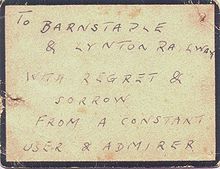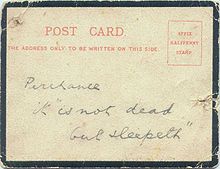
The South Tynedale Railway is a preserved, 2 ft narrow gauge heritage railway in Northern England and at 875 feet (267 m) is England's second highest narrow gauge railway after the Lynton and Barnstaple Railway in north Devon. The South Tynedale line runs from Alston in Cumbria, down the South Tyne Valley, via Gilderdale, Kirkhaugh and Lintley, then across the South Tyne, Gilderdale and Whitley Viaducts to Slaggyford in Northumberland.
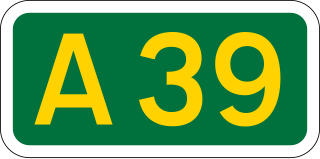
The A39 is an A road in south west England. It runs south-west from Bath in Somerset through Wells, Glastonbury, Street and Bridgwater. It then follows the north coast of Somerset, Devon and Cornwall through Williton, Minehead, Porlock, Lynmouth, Barnstaple, Bideford, Stratton, Camelford, Wadebridge and St Columb Major. It then joins the route of the A30 road for around 5 miles (8.0 km), re-emerging near Zelah to head for the south Cornish coast via Truro and Falmouth.

The Bideford Railway Heritage Centre CIC in Devon, England is a community interest company that is responsible for the management of the site of Bideford railway station. The company is also responsible for Instow signal box which opens on occasional Sundays and bank holidays from Easter to October.

The Cambrian Heritage Railways is a heritage railway company, trust and society based at both Llynclys and Oswestry in its restored Oswestry railway station, Shropshire, England.
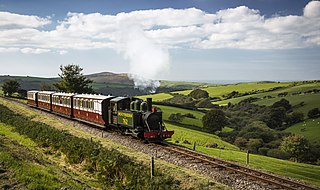
The Lynton and Barnstaple Railway (L&B) was a single track, 1 ft 11+1⁄2 in narrow gauge railway. It opened in May 1898 and ran for slightly more than 19 miles (31 km) through the area bordering Exmoor in North Devon, England. Although it opened after the Light Railways Act 1896 came into force, it was authorised and constructed before that act. It was authorised under its own Act of Parliament and built to higher standards than similar railways of the time. It was notable as the only narrow gauge railway in Britain that was required to use main-line standard signalling. For a short period, it earned a modest return for shareholders, but for most of its existence it made a loss. In 1923, the L&B was taken over by the Southern Railway, and eventually closed in September 1935.

Woody Bay is a bay on the North Devon coast of England, 3 miles (4.8 km) west of Lynton and 8 miles (13 km) east of Combe Martin with a stony beach. It lies in the civil parish of Martinhoe at the edge of the Exmoor National Park and is a waypoint on the South West Coast Path. There were once plans to develop the area to become a holiday resort.

The Walhalla Goldfields Railway is a 2 ft 6 in narrow gauge tourist railway located in the Thomson River and Stringers Creek valleys in Gippsland, Victoria, Australia, near the former gold-mining town and tourist destination of Walhalla.

Chelfham railway station was a station on the Lynton and Barnstaple Railway, a narrow gauge line that ran through Exmoor from Barnstaple to Lynton and Lynmouth in North Devon, England. The station stood at the head of the spectacular Chelfham Viaduct, and served the village of Chelfham below.
Parracombe railway station was a halt on the Lynton & Barnstaple Railway, a narrow gauge line that ran through Exmoor from Barnstaple to Lynton and Lynmouth in North Devon, England. The Halt which served the village of Parracombe comprised a simple wooden shelter and was not opened until 1 May 1899 — almost a year after the line was opened on 16 May 1898 — and closed along with the rest of the railway on 29 September 1935. It is planned this station will be reopened next by the Lynton & Barnstaple Trust. It will replace the station at Killington Lane a bit further to the north that was opened in 2006.
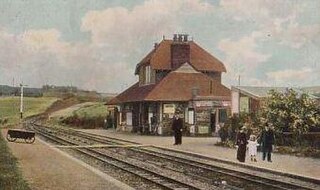
Woody Bay, within the Exmoor National Park, is a station on the former Lynton and Barnstaple Railway, a narrow gauge line that ran through Exmoor from Barnstaple to Lynton and Lynmouth in North Devon. The station was situated inland, about 1 1/2 miles from Woody Bay itself.
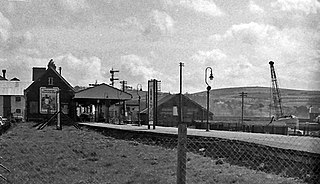
Barnstaple Town railway station was an intermediate station on the L&SWR line to Ilfracombe, England.
Pilton Yard, in Barnstaple was, between 1898 and 1935, the main depot and operating centre of the Lynton and Barnstaple Railway ('L&B'), a narrow gauge line that ran through Exmoor from Barnstaple to Lynton and Lynmouth in north Devon, England. Pilton station was served by regular passenger services advertised between 1898 and 1904 after which only goods facilities were provided. Passengers were catered for at the nearby LSWR station, Barnstaple Town, which provided connections with trains on the standard gauge branch line to Ilfracombe. The L&B's main offices were also based at Pilton, in a building formerly belonging to the Tannery which had earlier occupied the site, and which took over the site after the railway closed.
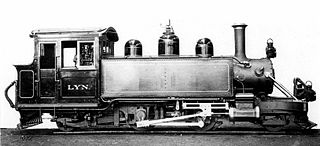
Lyn was a 2-4-2 tank steam locomotive built by the Baldwin Locomotive Works in 1898 for the Lynton and Barnstaple Railway in England. While the original Lyn was scrapped in 1935, a complete recreation of the locomotive exists, having been completed in 2017, and bears the same name as its precursor.
Killington Lane is a temporary terminus about one mile (1.6 km) southwest of Woody Bay on the Lynton and Barnstaple Railway (L&B), the narrow gauge line that originally ran for 19 miles (31 km) through Exmoor from Barnstaple to Lynton and Lynmouth in North Devon.
The Lynton and Barnstaple Railway Company Limited was a private company, limited by guarantee, with no share capital It was incorporated on 11 August 1993 as The Lynton & Barnstaple Light Railway Company Limited, the company was registered at Companies House in Great Britain as company number 02844182. The company was dissolved in 2009.
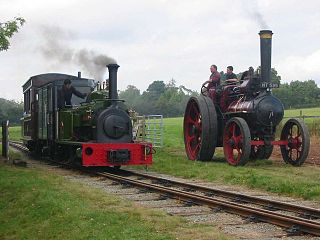
The Statfold Barn Railway is a narrow gauge railway based near Tamworth, Staffordshire and partially in Warwickshire, England. Founded by engineering entrepreneur Graham Lee and his wife Carol at their farm-based home, they originally designed what is still termed the garden railway, in which Graham could run his trains and Carol could design an extensive English country garden around a lake.
The Isle of Man Steam Railway Supporters' Association Ltd (IoMSRSA) is a railway preservationist group dedicated to ensuring the continued operation of the Isle of Man Railway on the Isle of Man. Since its inception in 1966 the group has provided volunteer workers, acted in a watchdog role and undertaken the restoration of the Groudle Glen Railway on the island, as well as supporting projects on the railway and producing the journal, Manx Steam Railway News.

Lyd is a narrow gauge steam locomotive built by the Ffestiniog Railway in their own Boston Lodge shops over a period of 15 years.

The Tarka Valley Railway in Devon, England, is a heritage railway that plans to rebuild the Torrington to Bideford section of the Barnstaple to Halwill Junction railway line. So far a short demonstration line of 300 yd of track in the direction of Bideford plus a siding alongside the old coal dock have been re-laid. The railway has been fenced off from the Tarka Trail ensuring the safety of all involved. Restoration of various items of rolling stock is currently under way.

Martinhoe is a small settlement and civil parish in North Devon district of Devon, England. Martinhoe is within the Exmoor National Park, the smallest National Park in England. In the 2011 census Martinhoe Parish was recorded as having a population of 159. Martinhoe is in the Combe Martin ward, for elections to the district council. Martinhoe's local government takes the form of a parish meeting and as such has no parish council nor elected parish councillors.
